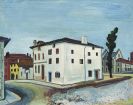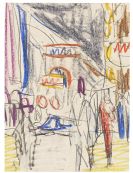
Rudolf Levy
Stettin
1875 -
Italien
1944
The scion of an entrepreneurial family, Rudolf Levy was born in Stettin on 15 July 1875. After passing the examinations qualifying for university entrance, Rudolf Levy enrolled at the at the Grand Ducal School for the Decorative and Applied Arts in Baden in 1895 but went to Munich in 1897, where he was instructed at private art schools.
At the plein air studio run by Zügel, Rudolf Levy studied the German and especially the French Impressionists and decided to go to Paris in 1903. There Levy came into contact with the "Café du Dôme" circle, showed work in 1905 at the Third Paris "Salon d'Automne", where pictures by the Fauves caused such a stir.
From 1907 Levy studied at the workshop with pupils newly established by Matisse. After showing work in 1912 at the "Sonderbund" exhibition in Cologne, the Stedelijk Museum in Amsterdam and elsewhere, Rudolf Levy was no longer able to participate in exhibitions during the first world war. Levy volunteered for the front and fought on the German side in France.
In the early 1920s Levy moved to Berlin, where Alfred Flechtheim organised Levy's first one-man show at his celebrated gallery. Until Rudolf Levy emigrated from Germany in 1933, he was on the board of directors and a member of the jury of the Berlin Secession.
From 1933 Levy travelled about from Mallorca to New York and back again to Europe, where he succeeded in staying temporarily in Italy. In December 1943 Rudolf Levy was arrested by the National Socialists in Florence and died in January 1944 while being transported to the Carpi internment camp at Modena with other Jewish prisoners.
Rudolf Levy's œuvre, much of which has been lost, consists mainly in landscapes and still lifes although there are also figurative paintings and portraits. Executed in a vibrant palette, Levy's paintings reveal the influence of Matisse, whose pupil he was, and Paul Cézanne, whose work Rudolf Levy had studied closely. During the 1920s Levy developed a synthesis of Expressionism and Realism, which increasingly assumed objective, occasionally even Neo-Classical characteristics.
During the emigration years Levy did more portraits, some on commission, and, because he was constrained to work in the studio, numerous still lifes. Levy's mature 1920s style continued on to perfection in his late work. Rudolf Levy's paintings are owned by many German public museums.
Would you like to sell a work by Rudolf Levy?
Infos for seller











